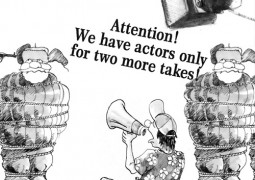Introduction to directing actors
(From “The Art of Directing Actors” book, by Ernest Goodman)
Film directing is a relatively young art form, emerging almost 100 years ago. Theater art, on the other hand, has existed for thousands of years. This book is about the art of directing actors, whether it is for film or for theater. The inner life of the actor, acting techniques, certain rules of human behavior, common mistakes of the director, and various methods of directing are discussed.
As working director, I believe, as well as many other teachers, directing actors can be taught as a craft. The art of directing actors does not need to be mystified. We study 17 tools of directing actors in my workshops (Directing Actors Intensive) and in The Art of Directing Actors book. All 17 methods of directing actors are relatively easy to understand and they can be learned in a reasonable amount of time.
Film school courses will often focus more on the technical aspects of directing, offering study in cinematography, editing, producing, etc. Of course a good director must be familiar with these arts, but they are not his or her main function. Only a few U.S. film schools offer students a course dedicated to the specific methods of directing actors. Given that this topic is multilayered, clearly one class would be insufficient to successfully realize this rich subject. With a hundred years of history, the art of directing actors is based on a clear and logical structure, as well as on the science of psycho-physiology. Many theatrical and film scholars have dedicated their lives to developing specific techniques for the directing of actors. Both acting and directing are complex, cumulative art forms; they must be taught and studied layer by layer. This subject is best studied in conjunction with the techniques of acting and this book is a synthesis of the concepts of many teachers and professionals.
In order to be a director you must have special training and intuition. Sometimes when teaching these methods, students will comment that certain techniques are illogical or against intuition. This is normal reaction. Intuition is very important and necessary for a director, but blindly following it usually leads to faulty results. To understand and know this multifaceted art form, it must be studied layer by layer; eventually leading to creating an exacting framework in which intuition can best work.
People often confuse intuition with inner emotions and some teachers believe that intuition can’t be taught as skill. But according to Allan Pease, an Australian body language expert and co-author of fifteen bestsellers, intuition is the ability to read people’s body language, a skill that can be taught. Body language is a reflection of our inner life, thoughts, emotions and feelings. Like intuition, Pease believes that reading body language enables you to determine whether the actor’s performance was truthful or not. But more importantly, the director should remain open and receptive to human emotions and feelings. It can be called intuition when we are watching a performance and as a gut reaction say, “I don’t believe it!” On the basis of your intuition, not your thinking, you determine whether or not the performance was truthful.
Most people can acquire the ability to read other people’s thoughts based on reading their body language, and this is a particularly crucial skill for a director. The Art of Directing Actors presents directing as a practical psychology: the art of managing human behavior.
Our workshops and The Art of Directing Actors book present directing actors as a practical psychology: the art of managing human behavior.
Tags directing actorsdirecting actors in Los Angelesdirecting actors workshops in Los AngelesGoodman directing actors methodGoodman directing studioGoodman on directing actors
You may also like...
Sorry - Comments are closed















